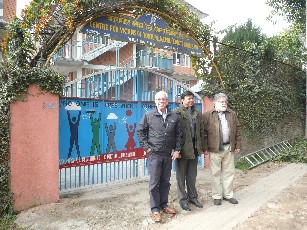
We are now on our first site visit in southern Nepal: Chitwan, a 900 sq km protected forest area and former hunting reserve for Nepali and British aristocrats. It was in this very jungle that King George V and his son, Edward VIII, managed to slaughter 39 tigers and 18 rhinos during a blood-soaked safari in 1911. We arrived in Chitwan at sunset, after a six hour drive downhill on a sinuous busy road 160 km south of Kathmandu, driving on the left lane of a two-way half-paved dusty road, navigating against hordes of speeding motorcycles tweeting their horns, overloaded trucks and overflowing buses, a sea of people on foot and ambulant vendors, a myriad of retail stores and ads, oscillating figures of porters with huge bulks in their shoulders, bicycles and tricycles, Buddhist and Hindu road side shrines and pagodas, pujas and prayers, screeching loudspeakers, drowsy buffalos, sleepy dogs, and hyper-alert goats…
Our first field visit in Chitwan was to Shaktikhor, one of the study villages about one hour ride from the Rhino Residency (our base hotel). We travelled through the heavy fog of a cool, all-gray dim morning light, which surrounded everything in a magical cloud of dust, fog and mist. Our group was composed of myself, Laurence Kirmayer, and Consuelo Errázuriz , as well as John Morstad (our resident photographer), Bhogendra Sharma (our Nepali partner and host), RP (aka Ram Prsad, a Nepali psychologist), and three young research assistants. We walked through the maze of small farmers’ houses and stores, goats, playing children and curious early risers, slowly rolling towards the edge of the village to interview a couple of informants. Our pace was slow, stopping every few steps in amazement to watch, shoot a photograph, ask for directions and have small talk with intercepting children and local villagers, as we greeted everyone with our praying hands closed to our chest and our first word in Nepali: namaste! (literally: I greet the divine inside of you). It was our first exposure to village life in Chitwan and we surely collected a few hundred photos thanks to John and Laurence who kept pointing and shooting their cameras as we walked through this memorable experience… our visit included open interviews, a healers’ therapeutic session, and lots of domestic scenes and animals.
The next morning, we took a longer stroll through the Tharu village and a site visit to the local health post before going back for lunch to Rhino Residency. After our first exposure to the exquisite Nepali cuisine, we discover momos: round steamed dumplings with variable and dubious fillings, which became our favourite dish and most celebrated second Nepali word: momo.
In late afternoon, we went for an elephant ride in a safari camp nearby which began at the United Elephant Booking Kiosk where we split the group between two elephants and climbed up the docking station. This was an exhilarating experience: Consuelo climbed first, followed by Duncan and Laurence, as the rest of the group climbed on top the second elephant. The view from the elephant’s top not only goes much further than your usual bipedal eyesight, but you certainly feel much safer, as rhinos, crocodiles, and other potentially dangerous creatures came across our path. It was two hours navigating on top of an elephant across the most beautiful silent jungle, intercepted by rhinos (including a female about to deliver a baby rhino), monkeys, deer, crocodiles and elegant birds, on a very different safari — almost a century after George and Edward’s infamous visit to this part of the world.
February 2, 2008